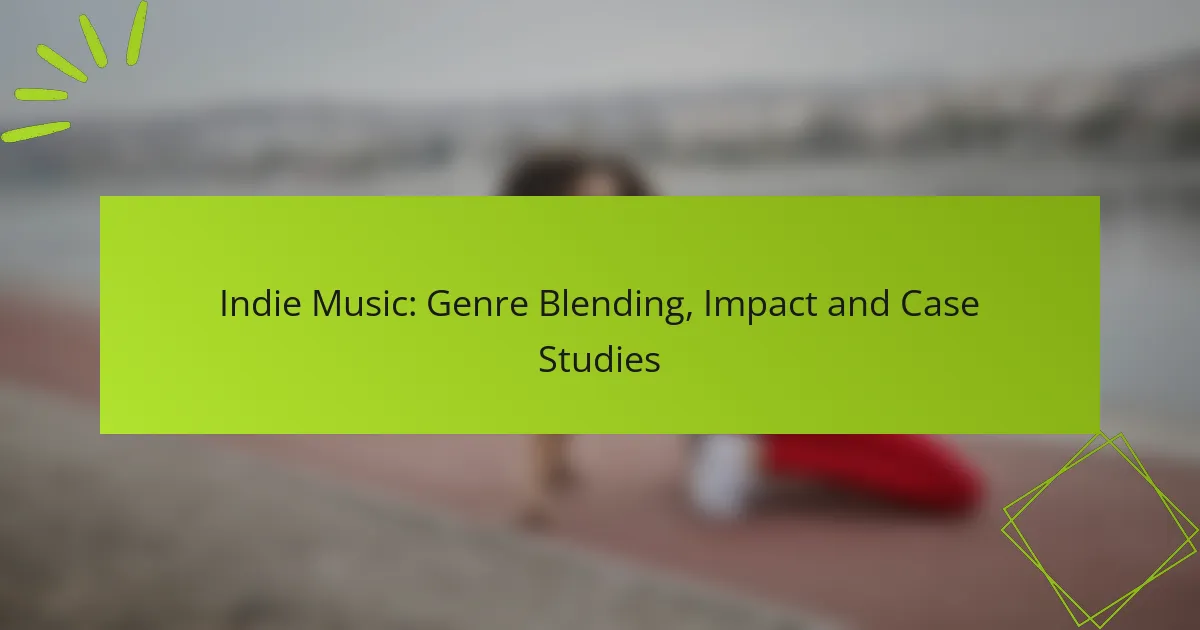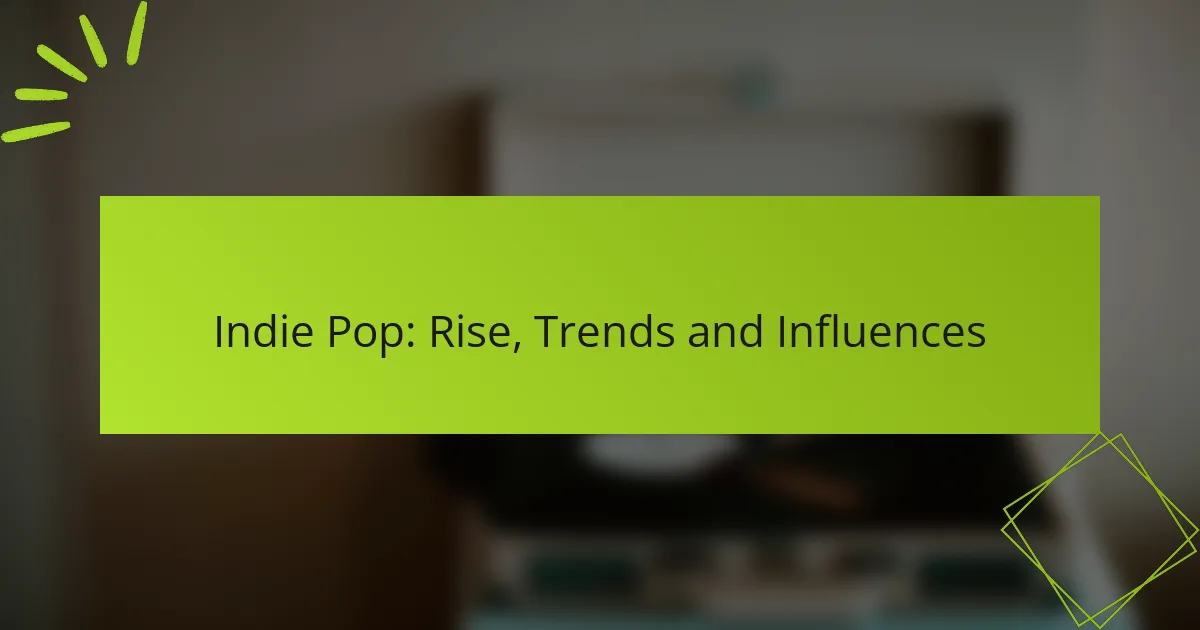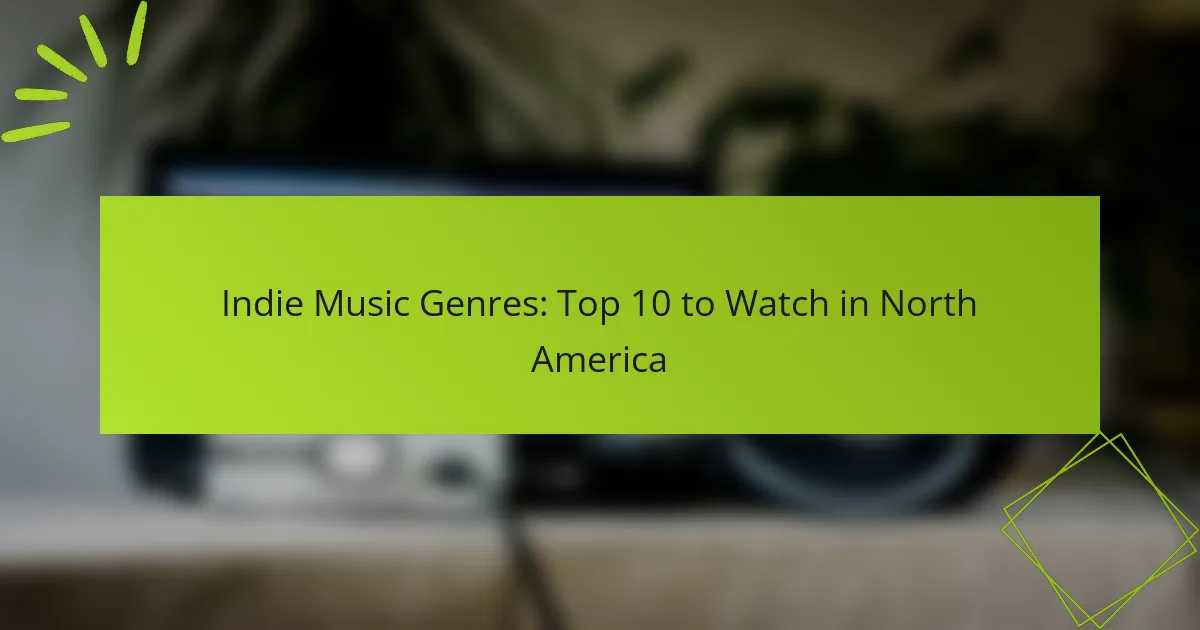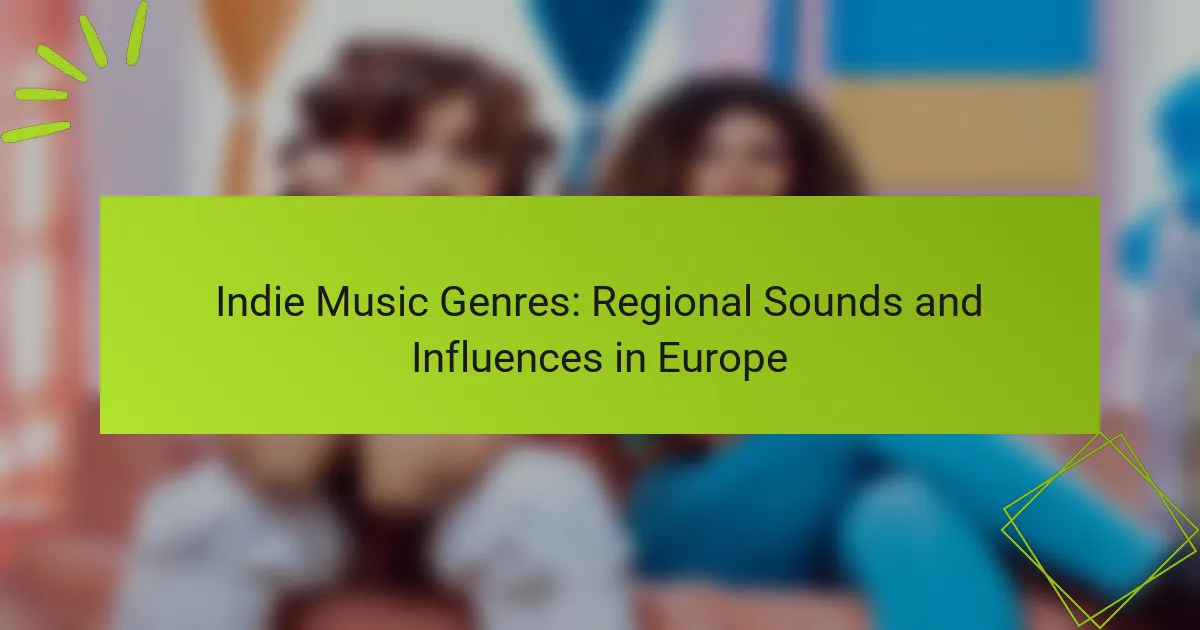Indie music thrives on genre blending, creating innovative sounds that push artistic boundaries and offer fresh listening experiences. This fusion not only reshapes the music landscape but also influences mainstream culture, altering consumption patterns and empowering independent artists. Through strategic marketing and collaboration, indie musicians can effectively reach wider audiences and establish unique identities in a diverse industry.
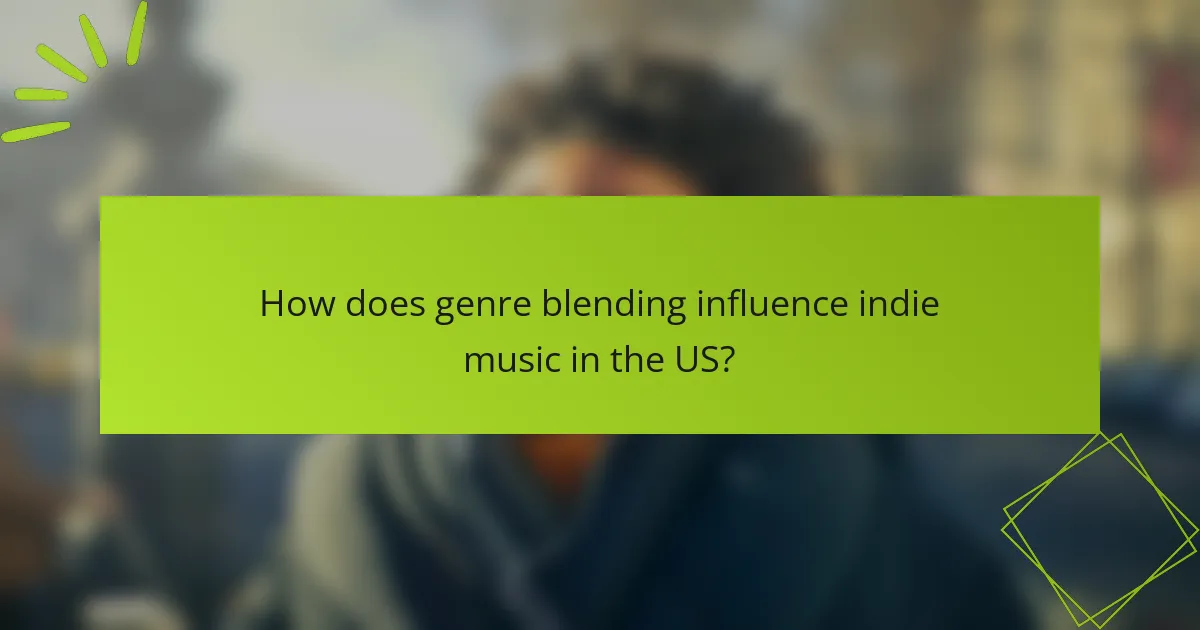
How does genre blending influence indie music in the US?
Genre blending significantly shapes indie music in the US by creating innovative sounds that push artistic boundaries. This fusion allows artists to experiment with various musical elements, resulting in fresh and diverse listening experiences.
Fusion of styles creates unique sounds
The combination of different musical styles in indie music leads to distinctive sounds that often defy traditional genre classifications. Artists might merge elements from rock, folk, electronic, and hip-hop, resulting in a rich tapestry of auditory experiences. This creativity not only showcases individual artistry but also invites listeners to explore new musical landscapes.
For instance, a band might incorporate electronic beats into a folk song, creating a fresh take on both genres. Such innovations can lead to the emergence of sub-genres, further enriching the indie music scene.
Attracts diverse audiences
Genre blending in indie music attracts a wide range of listeners by appealing to various musical tastes. Fans of different genres can find common ground in blended tracks, fostering a more inclusive music community. This diversity can enhance live performances, as audiences from different backgrounds come together to enjoy the music.
Moreover, artists who blend genres often gain exposure across multiple platforms, increasing their reach and fan base. This cross-pollination can lead to collaborations and partnerships that further enhance their visibility in the indie music landscape.
Examples of successful genre-blending artists
Several artists exemplify the successful blending of genres within the indie music scene. For example, Bon Iver combines folk with electronic elements, creating a unique sound that resonates with a broad audience. Similarly, Lizzo merges pop, hip-hop, and soul, appealing to fans across different musical preferences.
Other notable examples include the band Twenty One Pilots, which fuses rock, pop, and rap, and Hozier, who blends blues and indie rock. These artists demonstrate how genre blending can lead to commercial success while maintaining artistic integrity.

What are the key impacts of indie music on mainstream culture?
Indie music has significantly influenced mainstream culture by reshaping music consumption, altering the strategies of major record labels, and fostering the growth of independent music festivals. These impacts reflect a shift towards greater diversity and accessibility in the music industry.
Shifts in music consumption patterns
Indie music has contributed to a notable shift in how audiences consume music, with streaming platforms becoming the primary medium. Listeners now favor curated playlists and algorithm-driven recommendations, which often highlight independent artists alongside mainstream hits.
This change has led to a more democratized music landscape, where emerging artists can gain visibility without traditional marketing budgets. As a result, fans are increasingly discovering new genres and styles, fostering a culture of exploration and diversity in music preferences.
Influence on major record labels
The rise of indie music has prompted major record labels to adapt their business models and marketing strategies. Many labels now seek to sign independent artists or collaborate with them to tap into their unique sounds and dedicated fan bases.
This influence has led to a trend where major labels invest in smaller, niche genres, recognizing that these markets can yield substantial returns. As a result, artists have more leverage in negotiations, often securing better deals that allow for creative freedom.
Emergence of independent music festivals
Independent music festivals have surged in popularity, providing platforms for indie artists to showcase their work. These festivals often emphasize diverse lineups, featuring a mix of genres that reflect the eclectic nature of the indie scene.
Events like SXSW in the United States and Primavera Sound in Spain have become crucial for both artists and fans, fostering community and collaboration. Attendees often enjoy a more intimate experience compared to larger, mainstream festivals, enhancing the connection between performers and their audience.

How can indie artists effectively market their genre-blended music?
Indie artists can effectively market their genre-blended music by leveraging digital platforms, collaborating with other musicians, and utilizing streaming services. These strategies help reach wider audiences and create unique branding opportunities.
Utilizing social media platforms
Social media platforms are essential for indie artists to promote their genre-blended music. By sharing engaging content such as behind-the-scenes videos, live performances, and music snippets, artists can connect with fans and build a loyal following.
Focus on platforms like Instagram, TikTok, and Twitter, which are popular among music enthusiasts. Regularly posting updates and interacting with followers can enhance visibility and encourage fan engagement.
Collaborations with other artists
Collaborating with other artists can significantly boost an indie musician’s reach and introduce their genre-blended music to new audiences. Joint projects or features can create unique sounds that attract diverse listener demographics.
Consider partnering with artists from different genres to create innovative tracks. This not only enriches the music but also allows for cross-promotion, as both artists can share the collaboration with their respective fan bases.
Leveraging streaming services for exposure
Streaming services like Spotify, Apple Music, and Bandcamp are crucial for indie artists to gain exposure for their genre-blended music. These platforms often have curated playlists that can help new music reach a broader audience.
Indie artists should focus on submitting their tracks to playlists that align with their musical style. Engaging with listeners through these platforms can also lead to increased streams and potential revenue, especially when promoting new releases or upcoming shows.
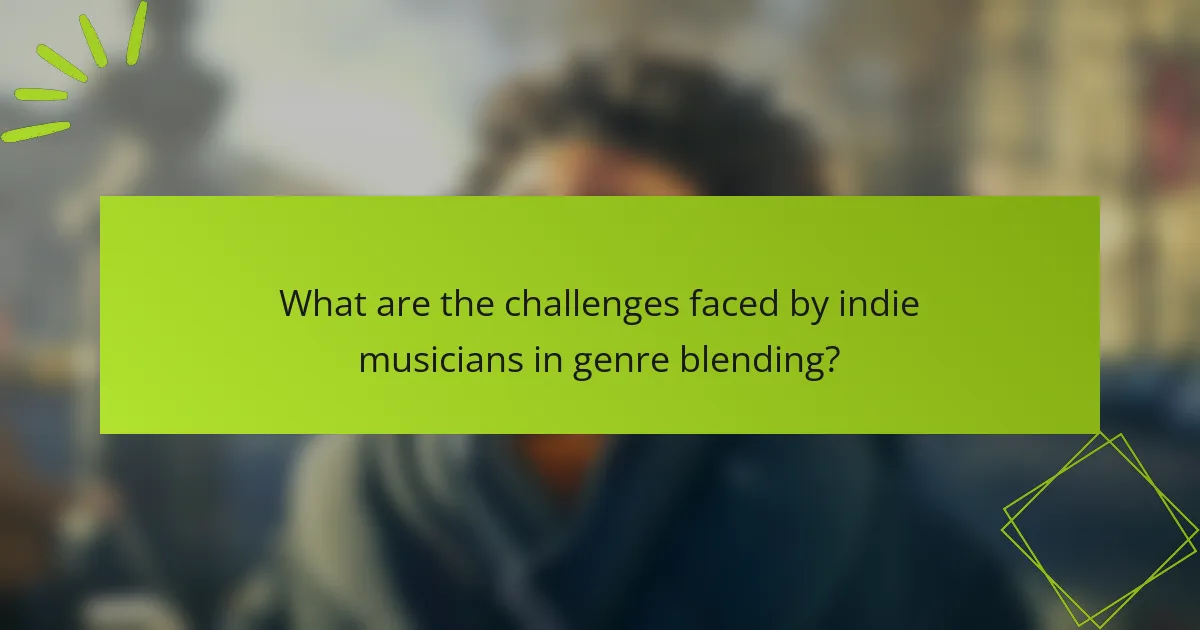
What are the challenges faced by indie musicians in genre blending?
Indie musicians often face significant challenges when blending genres, including maintaining their artistic vision while appealing to a broader audience. This balancing act can lead to conflicts between personal expression and marketability, making it crucial for artists to navigate these complexities effectively.
Balancing artistic integrity with commercial appeal
Indie musicians must find a way to stay true to their artistic integrity while also appealing to commercial interests. This often involves making tough decisions about which elements of their music to emphasize or downplay. For instance, an artist might choose to incorporate popular production techniques that resonate with listeners while still retaining their unique sound.
To achieve this balance, musicians can experiment with different styles and sounds, testing audience reactions through social media or live performances. Understanding the target audience’s preferences can help guide these decisions without compromising core artistic values.
Navigating industry gatekeepers
Indie musicians frequently encounter industry gatekeepers, such as record labels, radio stations, and streaming platforms, which can complicate genre blending. These entities often have specific expectations regarding genre classifications, making it challenging for artists to gain traction with innovative sounds. Building relationships with these gatekeepers requires persistence and strategic networking.
Musicians can increase their chances of success by creating a strong online presence and engaging with fans directly. Platforms like Bandcamp and SoundCloud allow artists to showcase their genre-blending work without relying solely on traditional industry channels.
Maintaining a consistent brand identity
For indie musicians, maintaining a consistent brand identity while exploring various genres is crucial for audience recognition. A clear brand helps listeners understand what to expect from an artist, even as they experiment with different sounds. This can be achieved through cohesive visuals, messaging, and thematic elements across all platforms.
To reinforce brand identity, artists should consider developing a signature style or recurring motifs in their music and marketing materials. Regularly engaging with fans through social media and live shows can also help solidify their brand, ensuring that even as they blend genres, their core identity remains intact.

Which indie music case studies exemplify successful genre blending?
Successful genre blending in indie music can be seen through artists who combine elements from various styles to create unique sounds. Billie Eilish, Twenty One Pilots, and Hozier are prime examples of how diverse influences can lead to innovative music that resonates with a wide audience.
Billie Eilish’s genre-defying sound
Billie Eilish has carved a niche for herself by blending pop, electronic, and alternative music elements. Her sound often features minimalist production, haunting melodies, and introspective lyrics, which set her apart from traditional pop artists.
Key to her success is the collaboration with her brother Finneas, who produces her tracks. This partnership allows for experimentation with different sounds and styles, resulting in a genre-defying aesthetic that appeals to a broad demographic.
Twenty One Pilots’ eclectic style
Twenty One Pilots exemplifies genre blending by merging rock, pop, hip-hop, and electronic music. Their ability to seamlessly transition between these styles in a single album creates a dynamic listening experience that attracts diverse fans.
Their lyrics often address personal struggles and mental health, resonating deeply with listeners. This emotional connection, combined with their varied musical influences, has led to significant commercial success and a loyal fan base.
Hozier’s fusion of folk and rock
Hozier combines elements of folk, rock, and blues to create a rich, soulful sound. His music often features intricate guitar work and powerful vocals, drawing from traditional Irish influences while appealing to modern rock audiences.
His breakout hit “Take Me to Church” showcases this fusion, blending poignant lyrics with a gospel-like intensity. Hozier’s ability to weave storytelling into his music enhances the emotional depth, making his genre-blending approach both impactful and memorable.
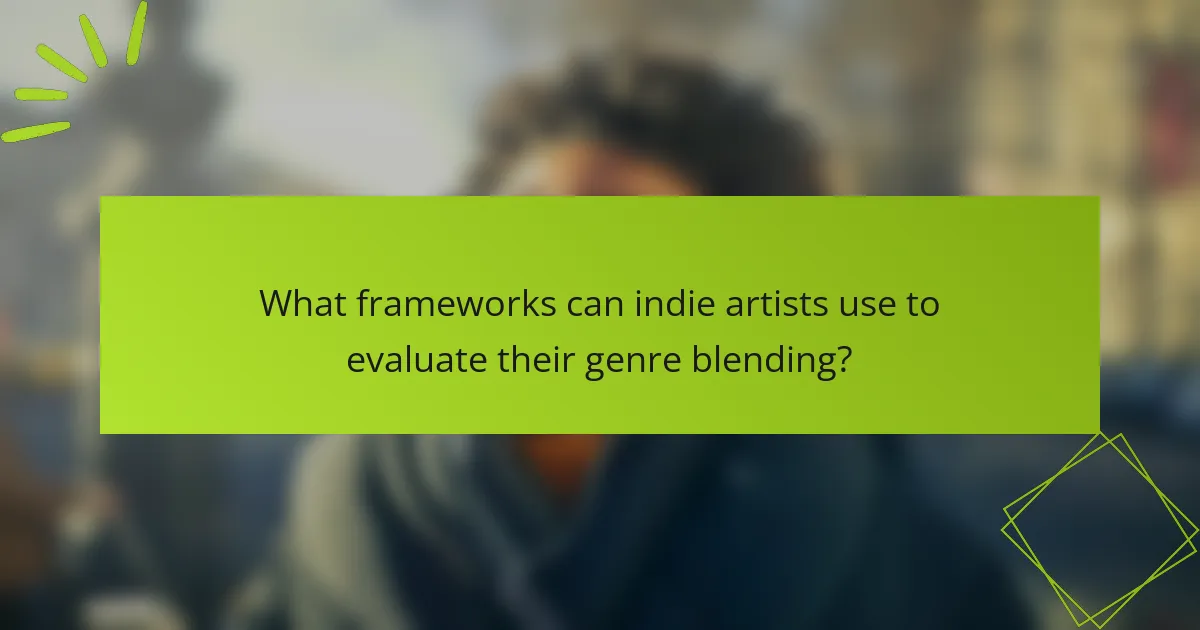
What frameworks can indie artists use to evaluate their genre blending?
Indie artists can utilize various frameworks to assess their genre blending, focusing on criteria for classification and audience feedback mechanisms. These frameworks help artists understand their musical identity and how it resonates with listeners.
Criteria for genre classification
When evaluating genre blending, artists should consider specific criteria such as instrumentation, lyrical themes, and production techniques. For example, a song that combines acoustic guitar with electronic beats may fall into both folk and electronic genres.
Another important aspect is the historical context of genres. Understanding how different genres evolved and influenced each other can provide insight into effective blending. For instance, the fusion of punk rock and hip-hop has created new subgenres that appeal to diverse audiences.
Audience feedback mechanisms
Gathering audience feedback is crucial for indie artists to evaluate their genre blending. This can be achieved through social media interactions, live performances, and streaming analytics. Engaging with listeners directly allows artists to gauge which elements resonate most.
Surveys and polls can also be effective tools for collecting feedback. By asking fans about their favorite aspects of a song or album, artists can identify successful genre combinations and areas for improvement. Regularly analyzing this feedback helps refine their musical approach and adapt to audience preferences.
